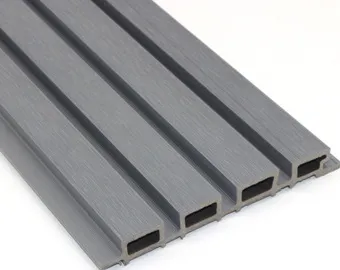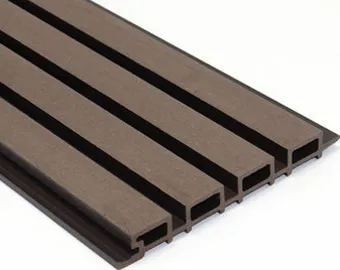Certainly! The primary difference between WPC fluted boards and WPC cladding lies in their appearance and the visual effects they create when installed. Here’s a detailed explanation of each:

WPC Fluted Boards
Appearance
- Grooved Surface: WPC fluted boards feature a series of parallel grooves or flutes along their surface. These grooves vary in width and depth, creating a textured and three-dimensional look.
- Textural Depth: The grooves in the fluted boards add depth and shadow, creating a dynamic and visually interesting pattern that changes with the light and angle of view.
- Modern and Stylish: The fluted design gives a contemporary and stylish appearance and is often used to create feature walls or accentuate specific architectural elements.
Visual Impact
- Accentuate Specific Areas: Fluted boards are typically used to highlight certain building areas, such as around windows, doors, or feature walls, adding a touch of sophistication and elegance.
- Breaks Monotony: The textured surface helps to break the monotony of flat walls, adding visual interest and complexity to the design.
- Creates Contrast: The grooves can create a contrast with smoother surfaces, drawing attention to specific design features and providing a unique aesthetic.
WPC Cladding
Appearance
- Smooth Surface: WPC cladding generally has a smooth, flat surface without the grooves or flutes found in fluted boards. This creates a uniform and sleek look.
- Consistent Finish: The smooth surface provides a consistent and cohesive finish, making it ideal for covering large areas or entire walls.
- Versatile Design: Available in various colors and finishes, WPC cladding can mimic natural wood, stone, or other materials, offering versatility in design.
Visual Impact
- Uniform Coverage: WPC cladding is often used to cover entire walls, providing a clean and polished look that enhances the overall appearance of the building.
- Seamless Integration: The smooth and consistent finish allows for seamless integration with other building materials and architectural elements.
- Elegant Simplicity: The simplicity of the smooth surface creates an elegant and understated aesthetic, suitable for both modern and traditional designs.
Comparison: WPC Fluted Boards vs. WPC Cladding
Design Elements
- WPC Fluted Boards: Grooved, textured surfaces that add depth and visual interest. Ideal for accenting specific areas and creating feature walls.
- WPC Cladding: Smooth, uniform surfaces that provide a sleek and cohesive look. Ideal for covering large areas or entire walls.
Applications
- WPC Fluted Boards: Used to highlight and accentuate specific architectural features. Suitable for small sections of exterior walls, around windows and doors, and courtyard decorations.
- WPC Cladding: Used for full wall coverage, providing a consistent and protective exterior finish. Suitable for residential homes, commercial buildings, and public areas.
Summary
In summary, WPC fluted boards and WPC cladding offer distinct visual effects and design possibilities. WPC fluted boards feature grooved surfaces that add texture and depth, making them ideal for accentuating specific areas and creating feature walls. WPC cladding, with its smooth and uniform surface, provides a sleek and cohesive look, perfect for covering large areas or entire walls. Both options offer durability, low maintenance, and versatile design choices, enhancing the aesthetic appeal and functionality of exterior spaces.




